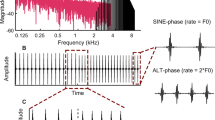Summary
The effects of low pass filtering on the brainstem auditory evoked potential (BAEP) were studied in the adult male rat. The bandpass of the recording system was progressively widened while the cut-off frequency of the high pass filter remained constant at 3.2 Hz. When the high frequency cut-off was 320 Hz or less, the principal waveform recorded in response to a click stimulus was a slow positive-negative complex. As the high frequency setting was raised from 800 Hz to 3.2 kHz, the slow components of the brainstem were replaced by four fast BAEP waves (I, II, III and IV). As the bandpass widened there was an increase in amplitude and a decrease in the absolute latency of all four fast waves in the order of 0.1 ms although the wave I–IV interpeak latency remained unaffected. The results confirm that the high frequency components of the BAEP are underlain by a slow positivity of uncertain origin followed by a slow negativity which probably arises within the inferior colliculus.
Similar content being viewed by others
References
Achor LJ, Starr A (1980a) Auditory brain stem responses in the cat. I. Intracranial and extracranial recordings. Electroenceph Clin Neurophysiol 48: 154–173
Achor LJ, Starr A (1980b) Auditory brain stem responses in the cat. II. Effects of lesions. Electroenceph Clin Neurophysiol 48: 174–190
Boston JR, Ainslie PJ (1980) Effects of analog and digital filtering on brain stem auditory evoked potentials. Electroenceph Clin Neurophysiol 48: 361–364
Buchwald JS, Huang C-M (1975) Far-field acoustic response: origins in the cat. Science 189: 382–384
Cacace AT, Shy M, Satya-Murti S (1980) Brainstem auditory evoked potentials: a comparison of two high-frequency filter settings. Neurology 30: 765–767
Davis H, Hirsh SK (1979) A slow brain stem response for low-frequency audiometry. Audiology 18: 445–461
Doyle DJ, Hyde ML (1981) Bessel filtering of brain stem auditory evoked potentials. Electroecenph Clin Neurophysiol 51: 446–448
Funai H, Funasaka S (1983) Experimental study on the effect of inferior colliculus lesions upon auditory brain stem response. Audiology 22: 9–19
Gardi J, Merzenich M, McKean C (1979) Origins of the scalprecorded frequency — following response in the cat. Audiology 18: 353–381
Hashimoto I, Ishiyama Y, Yoshimoto T, Nemoto S (1981) Brain stem auditory-evoked potentials recorded directly from human brain-stem and thalamus. Brain 104: 841–859
Hashimoto I (1982) Auditory evoked potentials from the human midbrain: slow brain stem responses. Electroenceph Clin Neurophysiol 53: 652–657
Huang C-M, Buchwald JS (1977) Interpretation of the vertex short-latency acoustic response: a study of single neurons in the brain stem. Brain Res 137: 291–303
Janssen R, Benignus VA, Grimes LM, Dyer RS (1986) Unrecognized errors due to analog filtering of the brain-stem auditory evoked response. Electroenceph Clin Neurophysiol 65: 203–211
Jewett DL (1970) Volume-conducted potentials in response to auditory stimuli as detected by averaging in the cat. Electroenceph Clin Neurophysiol 28: 609–618
Jewett DL, Romano MN (1972) Neonatal development of auditory system potentials averaged from the scalp of rat and cat. Brain Res 36: 101–115
Moller AR, Jannetta PJ (1982) Evoked potentials from the inferior colliculus in man. Electroenceph Clin Neurophysiol 53: 612–620
Picton TW, Hillyard SA, Krausz HI, Galambos R (1974) Human auditory evoked potentials. I. Evaluation of components. Electroenceph Clin Neurophysiol 36: 179–190
Plantz RG, Williston JS, Jewett DL (1974) Spatio-temporal distribution of auditory-evoked far field potentials in rat and cat. Brain Res 68: 55–71
Shaw NA (1986) The effect of pentobarbital on the auditory evoked response in the brainstem of the rat. Neuropharmacology 25: 63–69
Simpson GV, Knight RT, Brailowsky S, Prospero-Garcia O, Scabini D (1985) Altered peripheral and brainstem auditory function in aged rats. Brain Res 348: 28–35
Stockard JJ, Stockard JE, Sharbrough FW (1980) Brainstem auditory evoked potentials in neurology: methodology, interpretation, clinical application. In: Aminoff MJ (ed) Electrodiagnosis in clinical neurology. Churchill Livingstone, New York, pp 370–413
Thurlow WR, Gross NB, Kemp EH, Lowy K (1951) Microelectrode studies of neural auditory activity of cat: inferior colliculus. J Neurophysiol 14: 289–304
Wiederholt WC, Iragui-Madoz VJ (1977) Far field somatosensory potentials in the rat. Electroenceph Clin Neurophysiol 42: 456–465
Author information
Authors and Affiliations
Additional information
This study was supported by the Medical Research Council of New Zealand
Rights and permissions
About this article
Cite this article
Shaw, N.A. Effects of low pass filtering on the brainstem auditory evoked potential in the rat. Exp Brain Res 65, 686–690 (1987). https://doi.org/10.1007/BF00235994
Received:
Accepted:
Issue Date:
DOI: https://doi.org/10.1007/BF00235994




